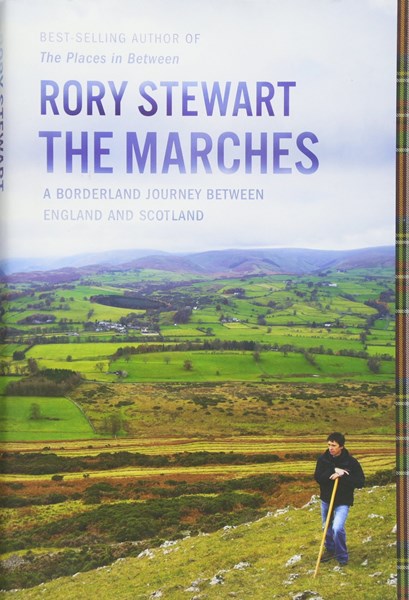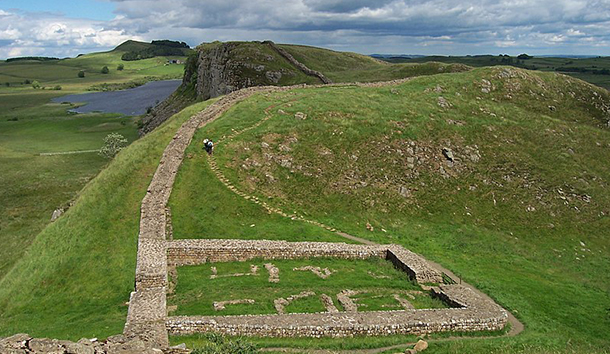What you might find on a long walk, a determined walk, a walk of exploration, you never know, of course, until you take the next step. And the next; and the next—in Rory Stewart’s case, across the constantly revelatory terrain of the borderlands shared since Roman times by England and Scotland.
To what end? Do we care?
There are ample reasons to care, starting with Stewart’s accomplishments as walker and earnest, informative tour guide: his eyes, ears, and notebook perpetually open, his native curiosity on constant display. Stewart’s compact chronicle of an extended walk through Afghanistan (of all places) in 2002 (of all times) earned him international acclaim and a raft of prizes.
The British, we have come to understand, are famous walkers through, and chroniclers of, fascinating, occasionally hostile, terrains: the late Patrick Leigh Fermor being possibly the most highly honored of the breed. Stewart on his present trajectory may achieve similar eminence.
So, first, what is a “march”? The military connotations of the word are not misplaced. A march is an ill-defined territory productive of deadly rivalry—“a zone of fighting and cross-border raids.” The land is Stewart’s own, figuratively and historically speaking: a rich wedge of territory between Scotland and England. His forebears here go back something like 3,000 years. His father, more specifically, represented the seventh generation to serve the Empire in Asia, then retire to the same Scottish locality.
Then, what’s this all about? I need to underscore the complexity of The Marches, a book that is more than a forced march, or a Baedeker ramble, through the pleasant, often challenging terrain of northern England and southern Scotland. It commences with a four-day stroll along the emperor Hadrian’s Wall; a landmark generally, if fuzzily, understood as shielding Roman Britain from the wild Scots to the north.
Stewart’s companion on the early, though not the later, stage of the journey was his father—the most interesting man in the book, for my money; even more of a distinct personality than his peripatetic son, with a colorful personal history of service in the Black Watch and the British secret service. The younger Stewart, by then an English Member of Parliament, living in Cumbria, had hoped to discover “that our histories and culture and soil”—Scotland’s, England’s—“were richly interwoven, with threads spreading far across the border.” It seemed a reasonable inference in the age of automobiles and mass communication. Yet somehow the Roman definition of the two lands persisted.
As I inquired at the start: Do we care? The Highland Scot in me says yes. But not just the Highland Scot—so also the observer of our troubled times and our morphing identities. Stewart brings us to something like greater clarity—or it could be less ambiguity—through two lenses: first, the intimate role of Scotland in the United Kingdom, yesterday’s and today’s; second, the fluidity of boundaries and groupings and loyalties, and by contrast the infidelities that clock and calendar visit upon us. One never puts foot twice into the same river, Heraclitus, the “weeping philosopher,” declares, not without cause.
Stewart—no dogmatist; more a lively and conscientious recorder of conversations and impressions—has much to show us, starting with a contradiction. The border is no real border; it marks without defining. Stewart, on his rambles, crosses eight times between England and Scotland. Hadrian’s Wall, which Stewart and his father explored for four days, was meant by the Romans as a fixity, dividing the civilized south of Britain from its rough-and-tumble north. Nothing quite worked, or lasted, as the emperor envisioned. Eventually, the soldiers withdrew to defend other endangered parts of the empire; new peoples arose to dispute the territory.
But who are the Scots and who the English? The sorting-out process is not so easy as one might think: kilts and bagpipes and hoot mons to the north, elevenses and cricket and BBC accents to the south. The point Stewart keeps making is that the sorting-out keeps occurring. The landscape stays in place, but people keep moving about. “Ninety percent of the people in the Borders,” he notes, “did not live in the place in which they were born.” Scotland seemed to Stewart—who had traversed Afghanistan, constantly discovering local ties and traditions—“hectically modern . . . its populations almost never in a single place for more than a couple of generations . . . ” A modern place in the modern world, the reader might reflect, marked by the comings and goings and flittings about made possible by modern communications and transport. Afghanistan never had the A1 motorway (and, on her present course, probably never will).
You puzzle out the idea of nationhood, peoplehood, against such a shifting backdrop. Differences remain: the product of
different legal systems and settlement patterns which had been shaped by the arbitrary, artificial impositions—the borders themselves—drawn by foreign emperors and domestic kings. The ghosts of these two lines—the old English-Scottish marches and its predecessor, Hadrian’s Wall—still divided what should have been almost indistinguishable parts of a single island.
Sir Walter Scott had carried forward the idea of “local attachments”—an idea that helped to bind Scots and English together as they mastered an empire. And yet the idea was slippery: not amenable to close examination. Tribal differences had national distinctions in the border culture beloved of Scott’s readers.
The point that rises to the top of this soufflé (or haggis) is the erasability of national and cultural distinctions under the influence of—what to call them?—outside influences. Stewart does not lean hard on this. (He implies, commonly, as opposed to lecturing—a mark of good companionship on the journey.) He talks of incessant mingling and disappearances among the peoples of the Middlelands—Roman soldiers from the present-day Rumania, and Northmen, and Normans, and Celts of one kind and another. And the English of the Borderlands, moving back and forth, some hardly knowing what country they were in, apart from its Britishness. Stewart notes that today’s Scotland—despite enduring impulses for formal separation from England—holds nearly as many speakers of Polish as of Gaelic.
I do not see Stewart as trying to impute a solution to America’s well-advertised border problem. He does expose some of the complexities that go with border associations: family ties, “impurities” in language development, cross-cultural quotings, and relaxed modes of dealing with differences. There is no need for policy extrapolations from Stewart’s narrative. Yet the narrative suggests that straightforward measures and methods—e.g, Hadrianic walls—have their practical limitations.
Yet that’s hardly the end of the story. Culture doesn’t matter? Only culture-melt is worthy of notice and celebration? Not as Brian Stewart, father of Rory and gusty, bracing presence throughout, would have it. Brian is of old stock: man of action; Scottish and British. “Our heroes were Scots connected to Empire,” he tells Rory, “and we were the best soldiers in the army. But we didn’t want to be a separate Scotland—we’d have thought it was boring—we wanted to be part of a British Empire.” It was all of a piece, the U.K.—for the greater good, the greater glory.
As postwar colonial administrator and diplomat, says the elder Stewart, “I felt I was serving the queen. . . . A cheerful way to go through life. No questions.” His was a life of clarity, in other words, based on no-longer-operative concepts like duty. And like, in the broad sense, love of country; country conceived as a collectivity of people with generally similar aims rather than as a viper’s pit of competing identities and ambitions. In all this, the kilt mattered; the pipes mattered. They summoned up heroic memories; they inspired.
That way of thought may be irreplaceable. Twenty-first-century liberals cannot dwell on the Empire—anybody’s empire—without groans of exasperation for white hierarchy and such stuff. Which is to ignore (along with much else) the ethic of selfless service and devotion the Empire coaxed into being from such as Brian Stewart.
The most touching part of The Marches is the Epilogue, wherein Rory Stewart, his journeying done, recounts the death of his 93-year-old father: a sad but entirely dignified parting. Theirs was some relationship, built on commonality of birth, background, and interests. They conversed and traveled together incessantly. The elder Stewart had resilience and a “delight in action.” His “Get On With It energy . . . made him reinvent himself daily, even in his tenth decade.” And made him, perhaps, a symbol to value—a man who gloried in tartan trews and tamo’shanter, like the proud Scot he was, but who understood the passage of time and made the most of it, loyal and undiscouraged as he put foot countless times into Heraclitus’ stream.
There were at the funeral the military pipers: the “Last Post,” then the quick marches from Black Watch days, “Hielan’ Laddie” and “Black Bear.” And at the last the dancing—an eightsome reel. “Or to be precise a fifty-sevensome. . . . Our feet were striking back and forth on the green turf.” Around and around, up and down—a whirl of tweed and kilts and blue bonnets. Thus Brian Stewart himself had danced—according to a form, the quadrille, perfected by the French, in the Sun King’s time. Rory’s nephew Gordon
danced on the ground in some combination of Russian Cossack and 1980s breakdance. . . . Everyone grasped that what mattered was not what it meant, or exactly how the dance was supposed to work—what mattered was to get on with it.

[The Marches: A Borderland Journey Between England and Scotland, by Rory Stewart (Houghton Mifflin Harcourt) 368 pp., $15.99]

Leave a Reply